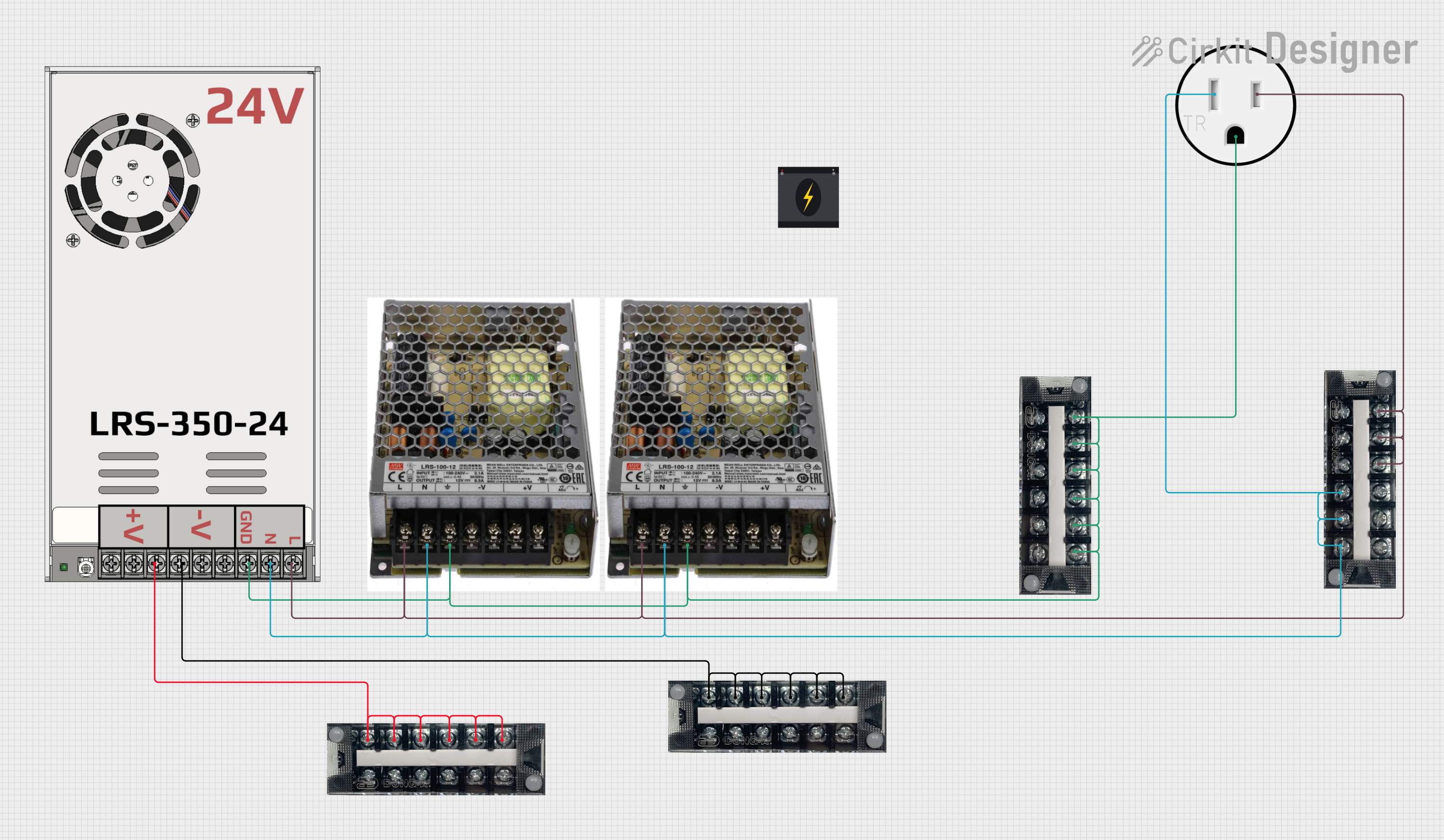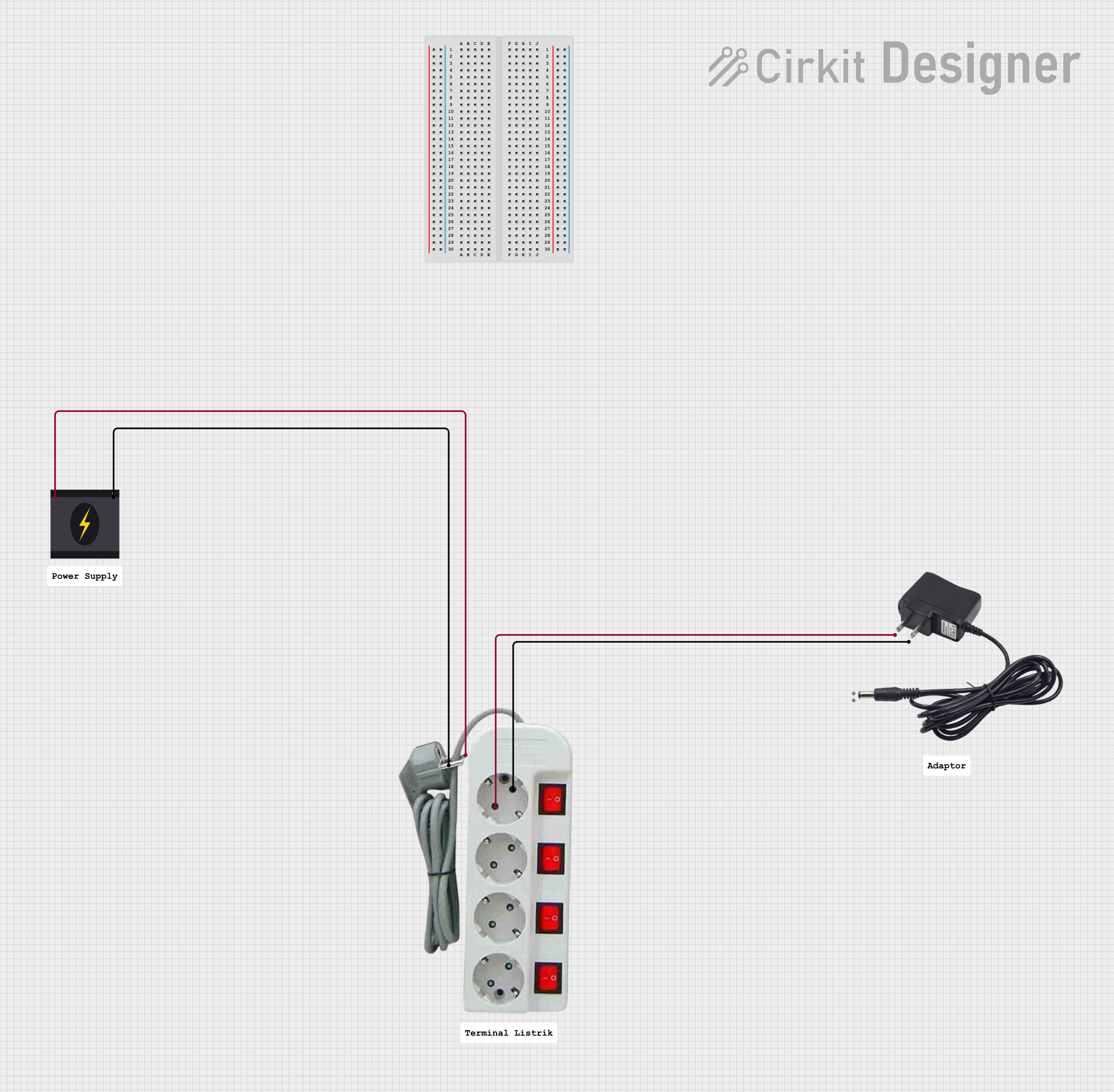
How to Use Power Supply Transformer 230 V to 12 V : Examples, Pinouts, and Specs

 Design with Power Supply Transformer 230 V to 12 V in Cirkit Designer
Design with Power Supply Transformer 230 V to 12 V in Cirkit DesignerIntroduction
The URAQT 200W-12 Power Supply Transformer is a robust and reliable device designed to step down high voltage AC (230 V) to a safer, lower voltage AC (12 V). This transformer is commonly used in electronic circuits to provide a stable power source for low-voltage devices. Its high efficiency and durable construction make it suitable for a wide range of applications, including home appliances, industrial equipment, and DIY electronics projects.
Explore Projects Built with Power Supply Transformer 230 V to 12 V

 Open Project in Cirkit Designer
Open Project in Cirkit Designer
 Open Project in Cirkit Designer
Open Project in Cirkit Designer
 Open Project in Cirkit Designer
Open Project in Cirkit Designer
 Open Project in Cirkit Designer
Open Project in Cirkit DesignerExplore Projects Built with Power Supply Transformer 230 V to 12 V

 Open Project in Cirkit Designer
Open Project in Cirkit Designer
 Open Project in Cirkit Designer
Open Project in Cirkit Designer
 Open Project in Cirkit Designer
Open Project in Cirkit Designer
 Open Project in Cirkit Designer
Open Project in Cirkit DesignerCommon Applications and Use Cases
- Powering low-voltage electronic circuits
- LED lighting systems
- Industrial control systems
- DIY electronics and prototyping
- Home automation systems
Technical Specifications
The following table outlines the key technical details of the URAQT 200W-12 Power Supply Transformer:
| Parameter | Specification |
|---|---|
| Manufacturer | URAQT |
| Part ID | 200W-12 |
| Input Voltage | 230 V AC ±10% |
| Output Voltage | 12 V AC ±5% |
| Maximum Power Output | 200 W |
| Frequency Range | 50 Hz / 60 Hz |
| Efficiency | ≥ 90% |
| Insulation Resistance | ≥ 100 MΩ |
| Operating Temperature | -10°C to 50°C |
| Dimensions | 120 mm x 80 mm x 70 mm |
| Weight | 1.2 kg |
Pin Configuration and Descriptions
The transformer has four terminals for input and output connections. The table below describes each terminal:
| Terminal | Label | Description |
|---|---|---|
| 1 | L | Live wire input (230 V AC) |
| 2 | N | Neutral wire input (230 V AC) |
| 3 | 12V~ | 12 V AC output (positive terminal) |
| 4 | 12V~ | 12 V AC output (negative terminal) |
Note: The output terminals (3 and 4) provide an alternating current (AC) voltage of 12 V. Polarity is not fixed for AC outputs.
Usage Instructions
How to Use the Transformer in a Circuit
- Safety First: Ensure the transformer is disconnected from any power source before handling or wiring.
- Input Connection:
- Connect the live wire (L) of the 230 V AC power source to the terminal labeled "L."
- Connect the neutral wire (N) of the 230 V AC power source to the terminal labeled "N."
- Output Connection:
- Connect the load (e.g., an electronic circuit or device) to the 12 V AC output terminals (3 and 4).
- Ensure the load does not exceed the transformer's maximum power output of 200 W.
- Power On:
- After verifying all connections, power on the transformer by supplying 230 V AC to the input terminals.
- Measure the output voltage using a multimeter to confirm it is approximately 12 V AC.
Important Considerations and Best Practices
- Overload Protection: Do not exceed the maximum power rating of 200 W to avoid overheating or damage.
- Ventilation: Ensure adequate airflow around the transformer to prevent overheating.
- Grounding: Properly ground the transformer to enhance safety and reduce electrical noise.
- Isolation: Use the transformer in circuits where electrical isolation between the input and output is required.
- AC to DC Conversion: If your application requires DC voltage, use a rectifier circuit and a smoothing capacitor after the transformer's output.
Example: Connecting to an Arduino UNO
If you need to power an Arduino UNO, you must first convert the 12 V AC output to 12 V DC using a rectifier circuit. Below is an example of how to connect the transformer to an Arduino UNO:
- Use a bridge rectifier and a smoothing capacitor to convert the 12 V AC output to 12 V DC.
- Connect the DC output to the Arduino's VIN pin and GND pin.
// Example Arduino code to blink an LED
// Connect an LED to pin 13 with a 220-ohm resistor
void setup() {
pinMode(13, OUTPUT); // Set pin 13 as an output
}
void loop() {
digitalWrite(13, HIGH); // Turn the LED on
delay(1000); // Wait for 1 second
digitalWrite(13, LOW); // Turn the LED off
delay(1000); // Wait for 1 second
}
Note: Ensure the rectified DC voltage is within the Arduino's input voltage range (7-12 V recommended).
Troubleshooting and FAQs
Common Issues and Solutions
No Output Voltage:
- Check the input connections to ensure the live and neutral wires are properly connected.
- Verify that the power source is supplying 230 V AC.
- Inspect the transformer for visible damage or overheating.
Output Voltage Too Low or Too High:
- Measure the input voltage to confirm it is within the specified range (230 V AC ±10%).
- Ensure the load connected to the output does not exceed the transformer's power rating.
Overheating:
- Check for proper ventilation around the transformer.
- Reduce the load if it exceeds the maximum power rating of 200 W.
Humming Noise:
- A slight humming noise is normal due to the magnetic field in the transformer.
- If the noise is excessive, ensure the transformer is securely mounted and not under excessive load.
FAQs
Q: Can this transformer be used outdoors?
A: No, the transformer is not weatherproof. Use it in a dry, indoor environment.
Q: Can I use this transformer to power DC devices directly?
A: No, the transformer outputs 12 V AC. You need a rectifier circuit to convert it to DC.
Q: What happens if I connect the output terminals in reverse?
A: Since the output is AC, polarity does not matter. However, ensure proper connections when converting to DC.
Q: Is the transformer compatible with 110 V AC input?
A: No, the transformer is designed for 230 V AC input only. Using 110 V AC will result in reduced output voltage.